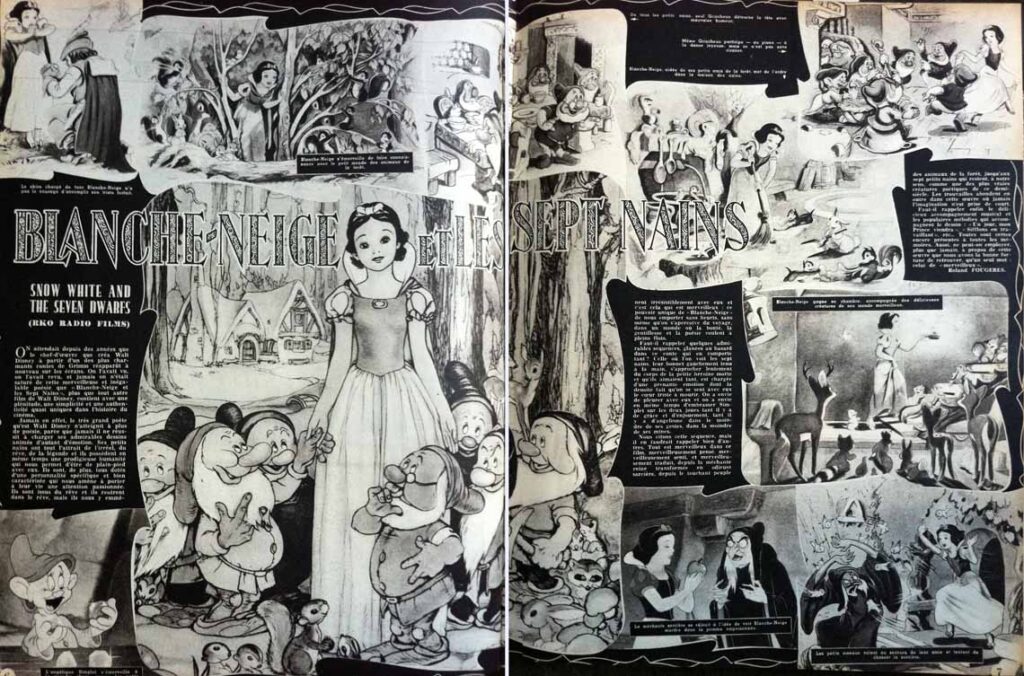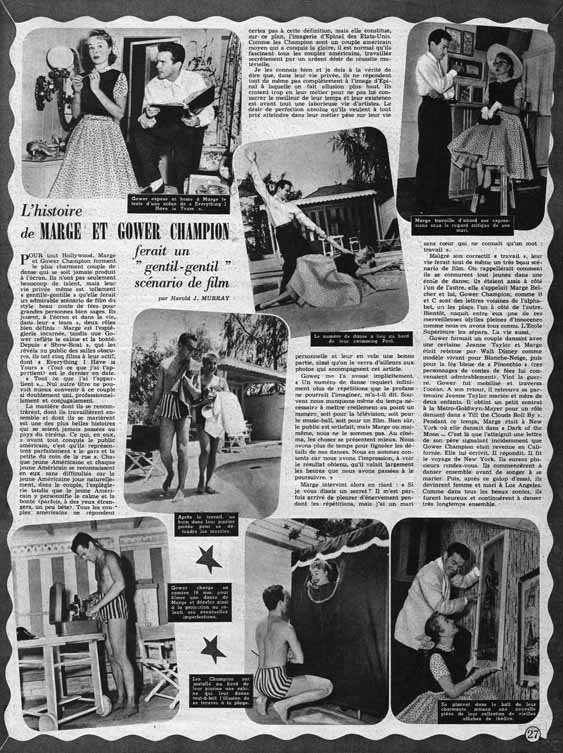Ciné- Revue is a French-language Belgian weekly magazine published from October 13, 1944 to the present day.
August 3, 1951
On August 3, 1951, a double-page illustrated article welcomed the return of Snow White and the Seven Dwarfs to the big screen in Belgium. Here is the text.
Snow White and the Seven Dwarfs
We’d been waiting for years for Walt Disney’s masterpiece based on one of Grimm’s most charming fairy tales to return to the silver screen. We’d seen it over and over again, and never once were we saturated with the marvelous, incomparable poetry that Snow White and the Seven Dwarfs, more than any other Walt Disney film, contains with a fullness, simplicity and authenticity that is almost unique in the history of cinema.
Indeed, never before has the great poet Walt Disney achieved so much poetry, because never before has he succeeded in loading his admirable cartoons with so much emotion. His little dwarfs have all the appeal of the unreal, of dreams, of legends, and at the same time he possesses a prodigious humanity that allows us to empathize with them. What’s more, they’re all endowed with a specific, well-characterized personality that leads us to pay passionate attention to their lives. They come from the dream and they enter the dream, but they take us irresistibly along with them, and that’s what’s so wonderful: Snow White‘s unique power to carry us along seamlessly, without us even noticing the journey, into a world where goodness, kindness and poetry flow freely. Need we recall a few admirable sequences, gleaned at random from this tale of so many? The one in which the seven dwarfs, their bonnets clumsily held in their hands, slowly approach the body of the dead little heroine they loved so much, is charged with a gripping emotion whose density made us feel with them a heart as sad as death. We want to cry with them, and at the same time kiss Dopey on both cheeks, so full of grace and playfulness, so angelic in the slightest of his gestures, in the slightest of his looks.
We’re quoting this sequence here, but there are many more to come. Everything is marvelous in this film, marvelously thought-out, marvelously felt and marvelously translated, from the wicked queen, transformed into an odious witch, to the touching people of the forest animals, to the seven little dwarfs who remain, in our opinion, one of the truest poetic creatures of this half-century. There is an abundance of new ideas in this work, which never fails to capture the imagination.
Last but not least, there’s the delightful musical accompaniment and the popular melodies that accompany the drawings: “Some Day My Prince Will Come”, “Whistle While You Work”, etc…. are certainly still fresh in everyone’s memory. So, now more than ever, we can only use one word to describe this work, which we have the good fortune to rediscover: “marvelous”.
Roland Fougères.
January 30, 1953
As “Everything I Have is Yours” is about to hit the screens, Ciné Revue dedicates an article about the dance team Marge and Gower Champion. Since their past is explored, Snow White is mentioned.
The story of Marge and Gower Champion would make a “nice-good” movie script
By Harold J. Murray
For all of Hollywood, Marge and Gower Champion are the most charming dance couple ever to grace the screen. Not only do they have a lot of talent, but their very private lives are so “nice-good” that they would make an admirable film script in the style of a fairy tale for well-behaved grown-ups. On screen and in life, they play two well-defined roles in their “team”: Marge is mischievousness incarnate, while Gower reflects calm and kindness. Since “Show-Boat” revealed them to the public, they have made five films, of which “Everything I Have is Yours” is the latest. “Everything I Have is Yours“… No other title could be more fitting for this couple so doubly united, professionally and conjugally.
The way they met, worked together and married is one of the most beautiful stories ever told in the land of cinema. What won them over above all else was the fact that they perfectly represented “the guy and gal on the corner”. Every American girl and boy can easily recognize themselves in them, as the American girl naturally plays the mischievous role in the couple, while the American boy personifies calm and kindness (sometimes, to foreign eyes, a bit silly). While not all American couples fit this definition, it is, in this respect, the epitome of American romance. Since the Champions are an average American couple who have conquered fame, it’s only natural that they should fascinate all American couples, secretly driven by an ardent desire for material success. I know them well, and it’s fair to say that in their private lives, they don’t quite live up to the image alluded to above. They believe in their profession too much not to devote the best part of their time to it, and their existence is above all a laborious life of artists. The desire for absolute perfection that they so desperately want to achieve in their profession weighs heavily on their personal lives and robs them of much of it, as can be seen from the photos accompanying this article.
Gower admitted as much to me. A dance number requires infinitely more rehearsal than the layman might imagine,” he told me. Often we don’t even have enough time to really develop a number, whether for television, music hall or film. Of course, the audience is satisfied, but Marge or I are not. In film, things are better. We have more time to work out the details of our dances. We’re happy about that, because we feel, seeing the result, that it was well worth the hours we spent pursuing it.”
Marge then laughed: “What if I told you a secret? I’ve sometimes cried during rehearsals, but I have a heartless husband who knows only one word: work. Despite her “work” corrective, their lives would still make a great movie script. We’d recall how they met as youngsters in a dance school; they sat next to each other, her name Marge Belcher and his, Gower Champion; as B and C are adjacent letters of the alphabet, they were placed next to each other. They soon formed one of those wonderful, innocent romances we’ve all known. High school separated them. So did life.
Gower formed a dancing couple with a certain Jeanne Taylor, and Marge was retained by Walt Disney as a live model for Snow White, then for the Blue Fairy in “Pinocchio” (these fairy-tale characters suited her admirably). Then came the war. Gower was drafted and sailed across the ocean. On his return, he found his partner Jeanne Taylor married, with two children. He landed a small contract at Metro-Goldwyn-Mayer for a dancing role in “Till the Clouds Roll By“. Meanwhile, Marge was in New York, dancing in “Dark of the Moon”. That’s when a letter from her father reached her, incidentally reporting that Gower Champion had returned to California. She wrote to him. He wrote back. He made the trip to New York. They had several dates. They started dancing together before thinking of getting married. Then, after this trial run, they became wife and husband in Los Angeles. As in all fairy tales, they were happy and continued to dance together for a very long time.


